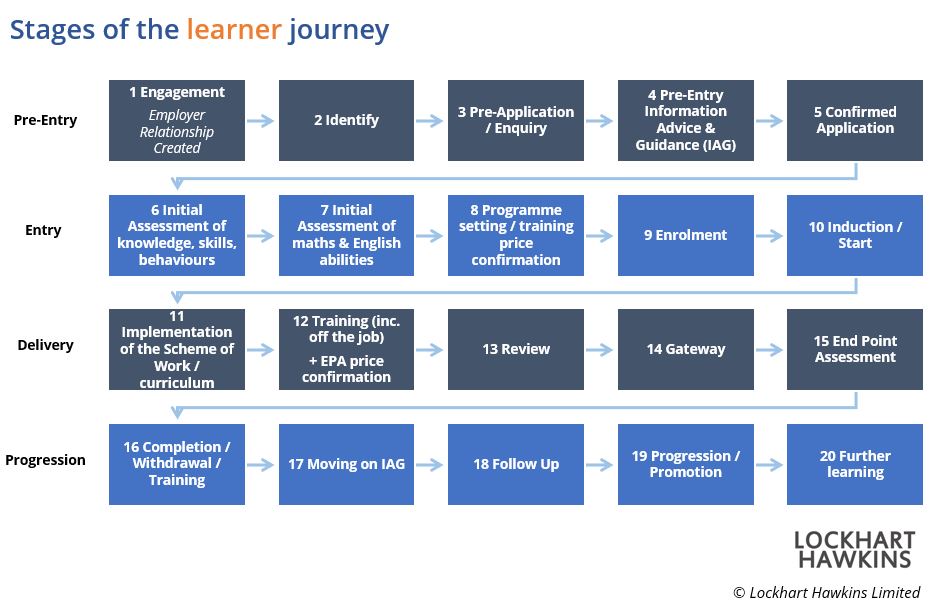
On 15 July 2020, the ESFA published their first iteration of the 2020-21 Apprenticeship Funding Rules.
Many providers have already started considering how the end of frameworks and new employer incentives will change their apprenticeship service, but what about the funding changes that haven’t necessarily made the headlines?
SDN’s compliance expert, David Lockhart-Hawkins, sets some of these out and gives his general thoughts on the direction the ESFA is taking…
(There’s also a link to an important session we’ve recorded, where David takes you through the practical implications of the funding rule changes, what this means for your delivery, and gives you the resources to take action… One not to miss!)
Seven key messages (the technical bit):
- Recording actualised off-the-job hours – we knew this was coming from the ILR specification, but the funding rules now make this requirement clear – actualised off-the-job hours have to be recorded in the ILR at end of the programme. This will apply to apprentices that started from 1 August 2019.
- Actualised hours of off-the-job variance – material variations (hours below those originally planned) look like this year’s big deal, requiring employer sign-off at the end or on-programme to agree they are satisfied with the quality (or, in reality, the price they paid). An update to the commitment statement is also required on-programme.
This is problematic for many provider delivery models, where the actualisation of hours is not linked to a clear programme curriculum or delivery module structure and where the commitment statement format is not particularly editable post-start. In particular:
- It will require a clear understanding of the reasons for material variation and when this occurs. Providers will need to develop clear policies to ensure consistency and give them adequate legal protections in their relationships with employers
- The solutions to this will need to be carefully considered. Broaching the subject of why an apprentice has spent less time on a programme may lead to some awkward conversations about the training price agreed
- It could lead to more price re-negotiation and employer relationship management
- Provider / employer contract templates will likely need updating to allow for re-negotiation
- The planning of off-the-job hours – though not a new rule, the variance rules above increase the need to understand where your learning hours occur. This is linked to having a clear understanding of your delivery model and having confidence there is a need for the model and associated hours. With the compliance aspect of initial assessment now really focused on proving ‘the need for learning’, the qualitative and compliance burden for providers has really increased and you’ll be fighting a losing battle if you do not understand the content and real duration of your curriculum (I’d certainly recommend you take a look at the work that Chris Cherry is doing on curriculum development). The initial assessment really needs to be against your planned curriculum, which itself should be modelled on the apprenticeship standard. Never has it been more important to understand what the necessary learning outcomes are.
- Proving redundancy status – if an apprentice has been made redundant by their employers, proof of redundancy (a copy of the dismissal notice) is now needed to allow for the continued delivery of the apprenticeship. If you don’t have this, then any continuation of funding would be overclaimed.
- Apprenticeship Agreements – the rules reiterated that this must be a separate document from Commitment Statements or other forms. Also, not directly mentioned in the rules but very important to note, is that extensions to the apprenticeship duration which may have been brought on by the COVID-19 shutdown will need agreement from employers. Be cautious with any fixed term contracts, as the apprentice needs to remain in employment for you to complete the learner. There is now clear grace of 30 days where new employment could be sourced without an apprentice counting as a withdrawal, but sourcing alternative employment is likely to be much harder now. The key details on the Apprenticeship Agreement are details of the practical period (training delivery) and end-point assessment (when it is expected to start and end) as well as the quantified number of planned off the job hours.
- No more apprenticeship frameworks – this has been in the pipeline for several years, but in case you missed it – you can’t start an apprentice on a framework from 1 August 2020. All new apprenticeship starts must be on apprenticeship standards. The conversion from frameworks to standards is far from simple and requires real curriculum overhaul and understanding of what is necessary to pass end-point assessment. Just re-branding your framework model won’t cut it and will likely cause issues with completion and success. (If you have front-line staff who are new to standards, this is a good place for them to start)
- As expected, the funding rules align with the recently announced COVID-19 flexibilities, including additional employer incentives. The additional payments for starts have temporarily increased, though an employer needs to enrol their apprentice via the digital Apprenticeship Service for these to be generated. I can see a lot of providers enrolling via their ESFA contract and an employer not getting the monies they expect. The continuation of functional skills achievement flexibilities will also help providers up to the start of the New Year.
So where are we heading?
Quite a number of the updates focus on transparency with the employer – in particular, off the job training variations, clarity on the delivery method that the employer (and government) are paying for, and any subsequent variations to that method, so the employer is satisfied with the impact and that they ‘got what they felt they paid for’.
This is likely to impact on the employer/provider relationship and the real risk here is not meeting employer expectations. Programmes with unclear content, usually a result of a lack of clarity on their own delivery model and limited evidence of actualisation of hours will have a much tougher time. So, the keys to getting compliance right remain curriculum design, initial assessment and evidencing engagement. If you’re deficient in any of these areas, then you know where you need to apply developmental resources.
How to practically implement the new funding rules
It’s relatively easy to note down a list of funding rule changes, but it’s more complex to evaluate their impact and how you might practically implement them in a way that is effective / efficient.
Using the stages of the learner journey as a guide – we’ve recorded a 2.5-hr webinar session to walk you through the changes, what it means operationally for different teams along the way, where new risks might arise and practical ways you can mitigate these.
Subscribing to the recording means you will also receive a detailed “Changes Action Plan” that identifies all the key changes and our recommendations for development and allow you to develop a detailed improvement plan.
Visit the webinar library for more details.

